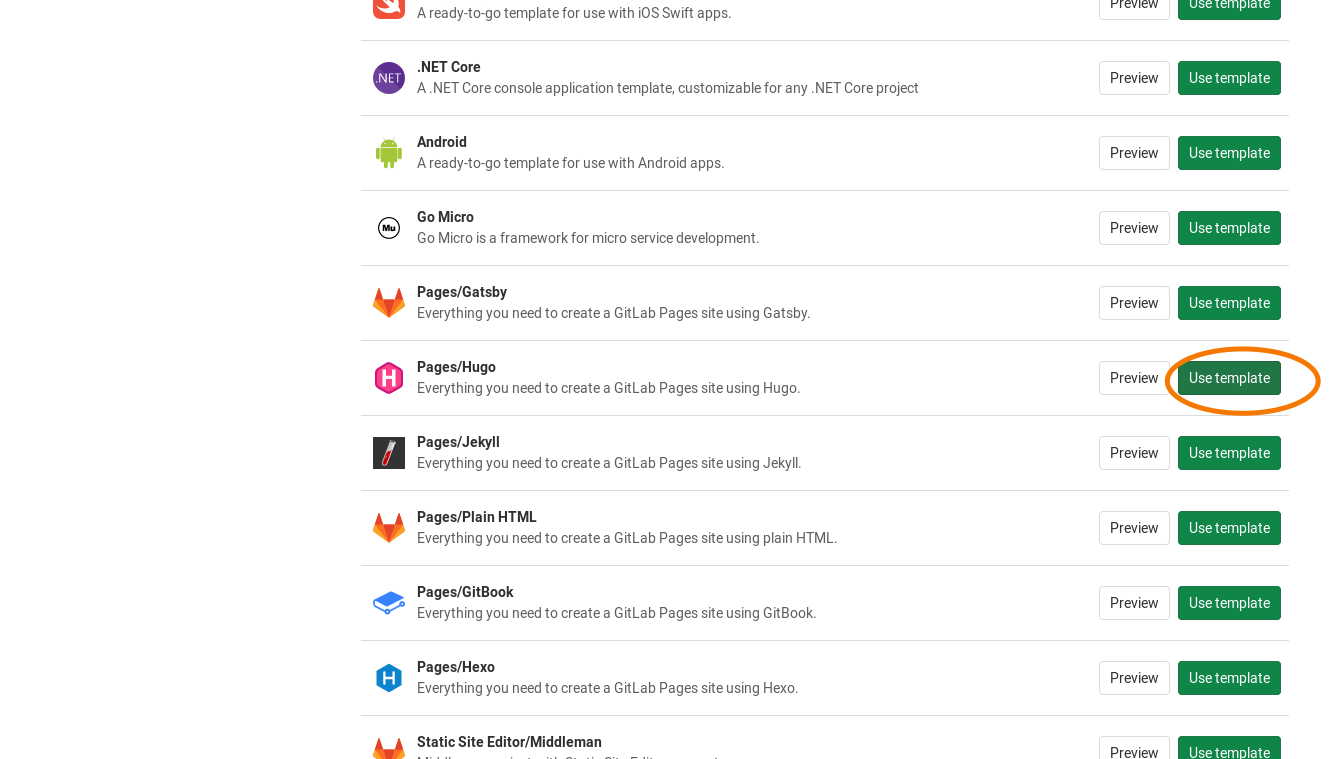Déployer un site web statique avec Hugo¶
1. Installer Hugo¶
Utilisez le tutoriel de la même rubrique: installer hugo
2. Création du projet sur Gitlab¶
2.1 Création d'un nouveau projet¶

2.2 Choix du template Hugo¶

3. Installation de l'environnement de travail¶
3.1 Installer les dépendances¶
sudo apt update
sudo apt install curl wget git3.2 Cloner le projet¶
git clone https://user.gitlab.io/my-website.git
cd my-website3.3 Installer hugo¶
3.3.1 Download the last version¶
curl -s https://api.github.com/repos/gohugoio/hugo/releases/latest \
| grep browser_download_url \
| grep linux-amd64.deb \
| grep extended \
| cut -d '"' -f 4 \
| wget -i - 3.3.2 Install it¶
sudo dpkg -i hugo*_linux-amd64.deb3.4 Run Hugo¶
hugo serveuser@domani:~/my-website$ hugo serve
Start building sites …
WARN 2020/09/30 22:21:44 Page.URL is deprecated and will be removed in a future release. Use .Permalink or .RelPermalink. If what you want is the front matter URL value, use .Params.url
WARN 2020/09/30 22:21:44 Page.Hugo is deprecated and will be removed in a future release. Use the global hugo function.
| EN
-------------------+-----
Pages | 35
Paginator pages | 1
Non-page files | 0
Static files | 23
Processed images | 0
Aliases | 9
Sitemaps | 1
Cleaned | 0
Built in 99 ms
Watching for changes in /home/user/my-website/{content,static,themes}
Watching for config changes in /home/user/my-website/config.toml
Environment: "development"
Serving pages from memory
Running in Fast Render Mode. For full rebuilds on change: hugo server --disableFastRender
Web Server is available at http://localhost:1313/hugo/ (bind address 127.0.0.1)
Press Ctrl+C to stopComme indiqué, allez voir à l'adresse http://localhost:1313/hugo/ votre site web.
Appuyez ensuite sur Ctrl+C pour stopper le serveur
4. Modifications¶
4.1 Le fichier config.toml¶
Ce fichier contient toute la configuration du site déployé par Hugo: les plugins utilisés, l'organisation des dossiers, l'url, la navigation dans le site, etc.
Modifiez au moins les éléments suivants:
baseurl = "https://garagenum.gitlab.io/web/my-website"
title = "H.E.E.I."
DefaultContentLanguage = "fr"
subtitle = "Handicap Enfance Et Insertion"Respectez bien l'indentation !
4.2 Le dossier des images¶
La configuration dans config.toml nous indique les chemins relatifs pour le logo
logo = "img/avatar-icon.png"
favicon = "img/favicon.ico"Nous devons donc créer le répertoire img, à partir du dossier static par défaut:
mkdir -p static/imget y mettre les fichiers avatar-icon.png et favicon.png
5. Mettre en ligne¶
5.1 Mettre en ligne avec gitlab¶
Il vous suffit de faire un commit pour intégrer vos changements, puis de pushvers la branche master.
Le fichier gitlab-ci.yml se charge en quelques minutes de mettre en ligne votre site à https://user.gitlab.io/my-website
5.2 Mettre en ligne sur votre propre serveur¶
Il vous suffit de lancer la commande hugo sans aucune option pour générer les fichiers statiques:
user@domani:~/my-website$ hugo
Start building sites …
WARN 2020/09/30 23:33:56 Page.URL is deprecated and will be removed in a future release. Use .Permalink or .RelPermalink. If what you want is the front matter URL value, use .Params.url
WARN 2020/09/30 23:33:56 Page.Hugo is deprecated and will be removed in a future release. Use the global hugo function.
| FR
-------------------+-----
Pages | 35
Paginator pages | 1
Non-page files | 0
Static files | 23
Processed images | 0
Aliases | 9
Sitemaps | 1
Cleaned | 0
Total in 144 mspublic et faites le servir par n'importe quel serveur web (Apache, Nginx, etc.)
user@domani:~/my-website$ ls public/ -l
total 96
-rw-r--r-- 1 user user 13067 sept. 30 23:33 404.html
drwxr-xr-x 2 user user 4096 sept. 30 23:33 categories
drwxr-xr-x 2 user user 4096 sept. 30 22:17 css
-rw-r--r-- 1 user user 15086 sept. 30 22:17 favicon.ico
drwxr-xr-x 2 user user 4096 sept. 30 23:00 img
-rw-r--r-- 1 user user 15773 sept. 30 23:33 index.html
-rw-r--r-- 1 user user 15569 sept. 30 23:33 index.xml
drwxr-xr-x 2 user user 4096 sept. 30 22:17 js
drwxr-xr-x 5 user user 4096 sept. 30 23:33 page
drwxr-xr-x 14 user user 4096 sept. 30 23:33 post
-rw-r--r-- 1 user user 3307 sept. 30 23:33 sitemap.xml
drwxr-xr-x 8 user user 4096 sept. 30 23:33 tags 6. Modifications avancées¶
Changer de thème¶
Vous pouvez trouver de nombreux thèmes, dont certains gratuits, à https://themes.gohugo.io/
Il vous faut alors télécharger le plugin dans le dossier themes
git submodule add https://github.com/janraasch/hugo-scroll.git themes/hugo-scrollVous trouverez généralement dans le theme un dossier exampleSite, dans lequel il y a un fichier config.toml dont vous pourrez vous inspirer.
Le paramètre essentiel dans config.toml est le nom du thème, par exemple:
theme = "hugo-scroll"